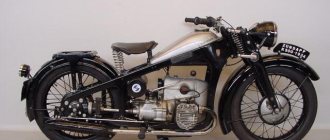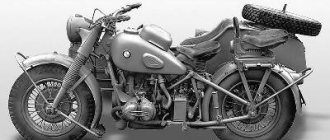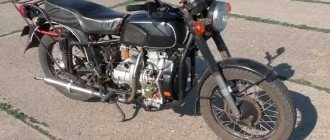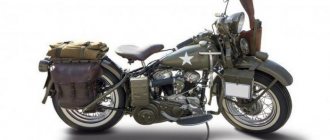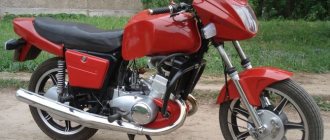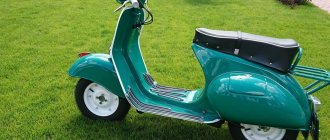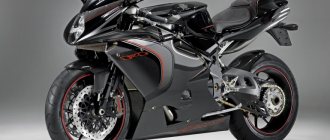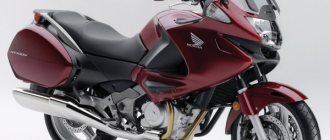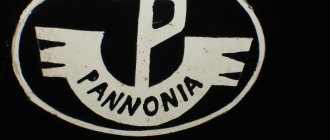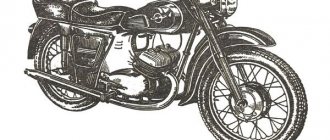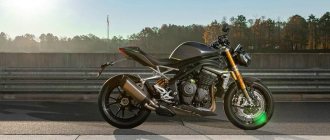The only motorcycle with a 4-cylinder engine during World War II
When it comes to motorcycles that were used during the Second World War, many remember those models that were built on the basis of the BMW brand. Of course, during the war there were plenty of them, but they were not considered advanced. The best motorcycle of the Wehrmacht has nothing to do with BMW. In addition, this vehicle was the only one with a 4-cylinder engine in the service of the Nazi army.
In ancient times, there was a company such as Zundapp in Germany. It was very famous in the mid-20th century and was even ahead of BMW in some segments. It was founded in 1917. After the war, the company, which was located in Nuremberg, began to have its first problems. They were associated, first of all, with a lack of financial resources. First, the plant was moved to Munich, and in 1984 the company ceased to exist on the market due to bankruptcy. At that time, the PRC authorities bought it and paid 16 million marks for it. The company retained assembly lines that were removed and delivered to the city of Tianjin. There, the new management managed to put the assembly lines back together and create a new brand - Tianjin Motorcycle Co. Throughout its not so simple history, Zundapp has worked according to one principle - simple and cheap. The greatest success was achieved in 1933, when solid power units rolled off the assembly line. We are talking about the K-600 and K-800 engines. Both engines were powerful and had 4 cylinders. They were paired with a 4-speed gearbox. The maximum power of the K-800 engine was 22 hp. even this figure was a serious achievement for the motorcycle industry of that time. Despite this, engines with the K index were easy to maintain and served for a long time. After some time, the Wehrmacht liked the Zundapp motorcycles and engines. This happened before World War II in 1937.
For its own needs, the Wehrmacht purchased Zundapp K-800 motorcycles, which added another letter to the name - W. If you look at the motorcycle of this sample, you will notice that the engineers tried their best to make the design as simple as possible. The civilian version did not offer any frills, and the army version was not at all attractive or well-thought-out design. As a result, the motorcycle turned out to be aggressive from all sides. He coped with all the tasks assigned with ease. Thanks to its simple design and powerful motor for that time, the motorcycle became popular among the Wehrmacht. In wartime, they were willingly taken as trophies. And after the end of the war, many motorcycles were redirected to the territory of the USSR as reparations for the damage caused. Over the entire existence of the model, over 7,500 Zundapp K-800 W motorcycles were produced in Germany. But even such a vehicle had its own weakness - the powerful power plant easily flooded the spark plugs and prevented quick start-up.
Bottom line . During World War II, the Wehrmacht made extensive use of Zundapp motorcycles. They were equipped with powerful motors and were reliable and easy to maintain.
Motorcycles | Germany
Motorcycle Ardie VF-125
The motorcycle was produced in 1942-1943. Motorcycle performance characteristics: length – 1.9 m; width – 0.7 m; height – 0.9 m; wheelbase – 1.3 m; weight – 78 kg; engine – single-cylinder, two-stroke; engine capacity – 123 cm³; engine power – 5 hp; gearbox – 3-speed; gas tank capacity – 10.5 l; fuel consumption – 1.7 l/100 km; maximum speed – 76 km/h; brakes - drum.
Motorcycle Ardie RBZ-200
The motorcycle was produced in 1937-1938. It had a stamped, trapezoidal front fork, a tubular frame and hanging tool bags. Motorcycle performance characteristics: weight – 105 kg; engine – single-cylinder, two-stroke; engine capacity – 197 cm³; engine power – 7 hp; gearbox – 4-speed; gas tank capacity – 13.5 l; fuel consumption – 3 l/100 km; maximum speed – 90 km/h; brakes - drum.
Motorcycle Ardie RBK-205
The motorcycle was produced in 1935-1936. It had a stamped, trapezoidal front fork, a tubular frame, a passenger seat, a footrest and a canvas tool bag. Motorcycle performance characteristics: weight – kg; engine – single-cylinder, four-stroke; engine capacity – 199 cm³; engine power – 9 hp; gearbox – 3-speed; gas tank capacity – 9 l; fuel consumption – 3 l/100 km; maximum speed – km/h; brakes - drum.
Motorcycle Ardie RBK-250
The motorcycle was produced in 1935. Performance characteristics of the motorcycle: engine - single-cylinder, four-stroke; engine capacity – 248 cm³; engine power – 12 hp
Motorcycle Ardie RBU-350
The motorcycle was produced in 1937-1938. Motorcycle performance characteristics: engine – single-cylinder, four-stroke; engine capacity – 343 cm³; engine power – 10 hp
Motorcycle Ardie 500
Motorcycle Ardie RBU-505 with sidecar
Motorcycle Ardie RBU-505
The motorcycle was produced in 1935-1937, both with and without a sidecar. Motorcycle performance characteristics: weight – 185 kg; engine – single-cylinder, four-stroke; engine volume – 497 cm³; engine power – 14 hp
Motorcycle Ardie RBK-503
The motorcycle was produced in 1933-1935. Motorcycle performance characteristics: engine – single-cylinder, four-stroke; engine capacity – 499 cm³; engine power – 22 hp
Motorcycle Ardie RBK-505
The motorcycle was produced in 1935-1938. based on the Ardie RBK-504 model. Motorcycle performance characteristics: weight – 175 kg; engine – single-cylinder, four-stroke; engine volume – 497 cm³; engine power – 20 hp; gearbox – 4-speed; gas tank capacity – 14 l; fuel consumption – 3.5 l/100 km; maximum speed – 100 km/h; drum brakes.
Motorcycle Ardie RBK-550
BMW R-2 motorcycle
The motorcycle was produced in 1931-1936. In total, at least 4 thousand cars were produced. Motorcycle performance characteristics: length – 2 m; width – 0.9 m; height – 1 m; wheelbase – 1.3 m; weight – 130 kg; engine – single-cylinder, four-stroke; engine capacity - 198 cm³; engine power – 8 hp; gearbox – 3-speed; gas tank capacity – 11 l; maximum speed – 95 km/h; brakes - drum.
BMW R-3 motorcycle
The motorcycle was produced in 1936. A total of 740 cars were produced. Motorcycle performance characteristics: weight – 149 kg; engine – single-cylinder, four-stroke; engine capacity – 305 cm³; engine power – 11 hp; gearbox – 4-speed; gas tank capacity – 12 l; maximum speed – 100 km/h; drum brakes.
BMW R-4 motorcycle
The motorcycle was produced in 1932-1937. in five modifications. A total of 15.3 thousand cars were produced. Motorcycle performance characteristics: weight – 137 kg; engine – single-cylinder, four-stroke; engine capacity - 398 cm³; engine power – 12 hp; gearbox – 4-speed; gas tank capacity – 12 l; maximum speed – 100 km/h; brakes - drum.
BMW R-5 motorcycle
The motorcycle was produced in 1936-1937. It had an all-metal frame made of stamped steel, a telescopic front fork, and two carburetors. The control panel has been integrated into the gas tank. A total of 2.7 thousand cars were produced. Motorcycle performance characteristics: length – 2.1 m; width – 0.8 m; height – 1 m; wheelbase - 1.4 m; weight – 165 kg; engine – two-cylinder, four-stroke; engine capacity - 494 cm³; engine power – 24 hp; gearbox – 4-speed; gas tank capacity – 15 l; maximum speed – 140 km/h; brakes - drum.
BMW R-6 motorcycle
The motorcycle was produced in 1937. A total of 1.9 thousand cars were produced. Motorcycle performance characteristics: length – 2.1 m; width – 0.8 m; height – 1 m; wheelbase - 1.4 m; weight – 175 kg; engine – two-cylinder, four-stroke; engine capacity – 594 cm³; engine power – 18 hp; gearbox – 4-speed; gas tank capacity – 15 l; fuel consumption – 3.5 l/100 km; maximum speed – 125 km/h; drum brakes.
BMW R-11 motorcycle with sidecar
Motorcycle BMW R-11
The motorcycle was produced in 1929-1935, both with and without a sidecar. It had a pressed steel frame and a cardan drive. A total of 7.5 thousand cars were produced. Motorcycle performance characteristics: length – 2.1 m; width – 0.8 m; height – 1 m; wheelbase - 1.4 m; ground clearance - 130 mm; weight – 162 kg; engine – two-cylinder four-stroke; engine capacity - 745 cm³; engine power – 18/20 hp; gearbox – 3-speed with reverse gear; maximum speed – 120/90 km/h; gas tank capacity – 14 l; fuel consumption – 4.5 l/100 km.
BMW R-12 motorcycle with sidecar
Motorcycle BMW R-12
The motorcycle was produced in 1935-1942. in two versions: “solo” and with a stroller. The motorcycle had a steel, stamped, perimetric frame and telescopic front suspension with hydraulic shock absorbers, as well as interchangeable wheels. The motorcycle was used at the beginning of the war by the Wehrmacht motorized rifle battalions. 10 thousand vehicles were produced for the needs of the Wehrmacht, although many civilian vehicles were requisitioned for the front. Motorcycle performance characteristics: length – 2.1 m; width – 0.9 m; height – 0.9 m; wheelbase - 1.4 m; weight – 185 kg; engine – two-cylinder, opposed; engine capacity - 745 cm³; engine power – 18/20 hp; gearbox – 4-speed; gas tank capacity – 14 l; maximum speed – 110 km/h; brakes - drum.
Motorcycle BMW R-16
The motorcycle was produced in 1929-1934. Motorcycle performance characteristics: weight – 165 kg; engine – two-cylinder, four-stroke; engine capacity – 735 cm³; engine power – 25 hp; gearbox – 3-speed; gas tank capacity – 14 l; maximum speed – 120 km/h; drum brakes.
Motorcycle BMW R-17
The motorcycle was produced in 1935-1937. A total of 434 vehicles were produced. Motorcycle performance characteristics: length – 2.1 m; width – 0.9 m; height – 0.9 m; wheelbase - 1.4 m; weight – 165 kg; engine – two-cylinder, four-stroke; engine capacity - 735 cm³; engine power – 33 hp; gearbox – 4-speed; gas tank capacity – 14 l; fuel consumption – 4.5 l/100 km; maximum speed – 140 km/h; brakes - drum.
BMW R-20 motorcycle
The motorcycle was produced in 1937-1938. A total of 5 thousand cars were produced. Motorcycle performance characteristics: length – 2 m; width – 0.8 m; height – 0.9 m; wheelbase – 1.3 m; weight – 130 kg; engine – single-cylinder, four-stroke; engine capacity - 192 cm³; engine power – 8 hp; gearbox – 3-speed; gas tank capacity – 12 l; fuel consumption – 2.6 l/100 km; maximum speed – 95 km/h; brakes - drum.
Motorcycle BMW R-23
The motorcycle was the result of the modernization of the R-20 and was produced in 1938-1940. Unlike its predecessor, it received a more powerful engine and a new generator. A total of 8 thousand cars were produced. Motorcycle performance characteristics: weight – 135 kg; engine – single-cylinder, four-stroke; engine capacity - 247 cm³; engine power – 10 hp; gearbox – 3-speed; gas tank capacity – 9.6 l; maximum speed – 100 km/h; brakes - drum.
BMW R-35 motorcycle
The civilian motorcycle was produced in 1937-1940. During the war, it was widely used in infantry units, police, and medical battalions. A total of 15.4 thousand cars were produced. Motorcycle performance characteristics: length – 2.2 m; width – 0.7 m; height 1 m; wheelbase - 1.4 m; weight – 155 kg; engine – single-cylinder, four-stroke; engine capacity - 342 cm³; engine power – 14 hp; gearbox – 4-speed; maximum speed – 100 km/h; gas tank volume – 12 l; fuel consumption – 3.5 l/100 km.
BMW R-51 motorcycle
The civilian motorcycle was produced in 1938-1940. and during the war it was requisitioned for the army. A total of 3.8 thousand cars were produced. Motorcycle performance characteristics: length – 2.1 m; width – 0.8 m; height – 1 m; wheelbase - 1.4 m; weight – 182 kg; engine – two-cylinder opposed overhead valve; engine capacity – 494 cm³; engine power – 24 hp gearbox – 4-speed; gas tank capacity – 14 l; maximum speed - 140 km/h.
BMW R-61 motorcycle with sidecar
Motorcycle BMW R-61
The civilian motorcycle was produced in 1938-1941. in two versions: solo and with a stroller. The motorcycle had a double tubular steel frame and telescopic front suspension. Motorcycles were supplied to the Dutch and German armies. A total of 3.7 thousand cars were produced. Motorcycle performance characteristics: length – 2.1 m; width – 0.8 m; height – 1m; wheelbase - 1.4 m; ground clearance - 120 mm; seat height – 0.7 m; weight – 210 kg; engine – two-cylinder opposed; engine capacity - 600 cm³; engine power - 18 hp; gearbox – 4-speed; gas tank capacity – 14 l; maximum speed – 115 km/h; brakes - drum.
Motorcycle BMW R-62
The motorcycle was produced in 1928-1929. A total of 4.4 thousand cars were produced. Motorcycle performance characteristics: length – 2.1 m; width – 0.8 m; height – 1m; wheelbase - 1.4 m; weight – 155 kg; engine – two-cylinder, four-stroke; engine capacity – 745 cm³; engine power - 18 hp; gearbox – 3-speed; gas tank capacity – 12.5 l; fuel consumption – 5 l/100 km; maximum speed – 115 km/h; brakes - drum.
BMW R-66 motorcycle with sidecar
Motorcycle BMW R-66
The civilian motorcycle was produced in 1938-1941. in two versions: solo and with a stroller. The motorcycle had a double tubular steel frame and telescopic front suspension and had no chrome parts. During the war, motorcycles were requisitioned for the army. A total of 1.7 thousand cars were produced. Motorcycle performance characteristics: length – 2.1 m; width – 0.8 m; height 1 m; wheelbase - 1.4 m; ground clearance - 120 mm; seat height – 0.7 m; weight – 21 kg; engine - two-cylinder opposed; engine capacity - 597 cm³; engine power - 30 hp; gearbox – 4-speed; gas tank capacity – 14 l; maximum speed – 145 km/h; brakes - drum.
BMW R-71 motorcycle with sidecar
Motorcycle BMW R-71
The motorcycle was produced in 1938-1941, both with and without a sidecar. It had a tubular frame, front and rear telescopic suspension; A total of 3.5 thousand cars were produced. Motorcycle performance characteristics: length – 2.1 m; width – 0.8 m; height – 1 m; wheelbase - 1.4 m; weight – 187 kg; engine – two-cylinder, four-stroke, bottom-drill; engine capacity – 746 cm³; engine power – 22 hp; gearbox – 4-speed with reverse gear; gas tank capacity – 14 l; maximum speed – 125/105 km/h; fuel consumption – 4.5 l/100 km; brakes - drum.
BMW R-75 motorcycle
The motorcycle was produced in 1940-1944. and was intended to transport three people in difficult road conditions with a trailer. It had a tubular welded frame, telescopic front suspension, and a magneto equipped with a mechanism for automatically adjusting the ignition timing. The crankshaft had a long journal at the front end that passed right through the engine crankcase. The generator rotor was mounted on this axle. Thanks to the reduction gearbox, the motorcycle had eight forward gears and two reverse gears. A total of 18 thousand cars were produced. Motorcycle performance characteristics: length – 2.4 m; width – 1.7 m; height - 1 m; wheelbase - 1.4 m; ground clearance – 150 mm; weight – 420 kg; engine – two-cylinder, four-stroke overhead valve with opposed cylinder arrangement; engine capacity - 746 cm³; engine power – 26 hp; gas tank capacity – 24 l; maximum speed – 92 km/h; Power reserve – 360 km; brakes - drum brakes with hydraulic drive, including the sidecar wheel.
Motorcycle DKW RT-100
The motorcycle was produced in two versions: in 1934-1936. with a 2.5 hp engine; in 1936-1940 with a 3 hp engine. A total of 72 thousand cars were produced. Motorcycle performance characteristics: length – 2 m; width – 0.7 m; height – 1 m; wheelbase – 1.2 m; weight – 45/54 kg; engine – single-cylinder, two-stroke; engine volume – 98 cm³; engine power – 2.5/3 hp; gearbox – 3-speed; maximum speed – 60/65 km/h.
Motorcycle DKW RT-125
The civilian motorcycle was produced in 1940-1944. It had a foot shift lever, a tubular frame and a parallelogram front fork. In total, 12 thousand vehicles were produced for the army. Motorcycle performance characteristics: length – 2 m; width – 0.7 m; saddle height – 0.7 m; wheelbase - 1.2 m; ground clearance – 150 mm; weight – 91 kg; engine – single-cylinder, two-stroke; engine capacity - 123 cm³; engine power – 6.5 hp; gearbox – 4-speed; maximum speed – 90 km/h; gas tank capacity – 9 l; fuel consumption – 2.5 l/100 km.
Motorcycle DKW KM-200 with sidecar
The motorcycle was produced in 1934-1936. It had a single stamped frame. A total of 30.4 thousand cars were admitted. Motorcycle performance characteristics: length – 2 m; width – 0.7 m; height – 0.8 m; wheelbase – 1.3 m; weight – 180 kg; engine – single-cylinder, two-stroke; engine capacity – 198 cm³; engine power – 6 hp; gearbox – 3-speed; maximum speed – 85 km/h; gas tank capacity – l; fuel consumption – l/100 km; brakes - drum.
Motorcycle DKW KM-200
Motorcycle DKW KS-200
The motorcycle was the result of a modernization of the KM-200 model and was produced in 1936-1940. It differed from its predecessor in a reinforced and expanded frame. A total of 58.6 thousand cars were produced. Motorcycle performance characteristics: engine – single-cylinder, two-stroke; engine capacity – 199 cm³; engine power - 7 hp; fuel consumption – 3 l/100 km; maximum speed – 90 km/h.
Motorcycle DKW SB-200
The motorcycle was produced in 1936-1938. A total of 60.4 thousand cars were admitted. Motorcycle performance characteristics: length – 2 m; width – 0.8 m; height – 1 m; wheelbase – 1.3 m; weight – 135 kg; engine – single-cylinder, two-stroke; engine volume – 192 cm³; engine power – 7 hp; gearbox – 3-speed; maximum speed – 90 km/h; gas tank capacity – 13 l; fuel consumption – 3l/100 km; brakes - drum.
Motorcycle DKW SB-250
The motorcycle was produced in 1938. Performance characteristics of the motorcycle: engine - single-cylinder, two-stroke; engine capacity – 247 cm³; engine power – 10 hp; gearbox – 3-speed.
Motorcycle DKW SB-350
The motorcycle was produced in 1937. Motorcycle performance characteristics: length - 2 m; width – 0.8 m; height – 1 m; wheelbase - 1.4 m; weight – 125 kg; engine – single-cylinder, two-stroke; engine volume – 342 cm³; engine power – 10 hp; gearbox – 3-speed.
Motorcycle DKW SB-500 with sidecar
Motorcycle DKW SB-500
The motorcycle was produced in 1934-1939. A total of 19.6 thousand cars were produced. Motorcycle performance characteristics: length – 2.1 m; width – 0.9 m; height – 0.9 m; wheelbase - 1.4 m; ground clearance - 115 mm; weight – 165 kg; engine – two-cylinder, two-stroke; engine capacity – 494 cm³; engine power – 15 hp; gearbox – 3-speed; gas tank capacity – 13 l; fuel consumption – 4.5 l/100 km; maximum speed – 105/115 km/h.
Motorcycle DKW NZ-250
The motorcycle was produced in 1938-1941. It had a pressed steel frame and parallelogram front fork. A total of 26.7 thousand cars were produced. Motorcycle performance characteristics: length – 2 m; width – 0.8 m; height 0.8 m; saddle height – 0.7 m; wheelbase - 1.4 m; ground clearance - 120 mm; weight – 135 kg; engine - single-cylinder, two-stroke; engine capacity – 247 cm³; engine power – 9 hp; gearbox – 4-speed; gas tank capacity – 14 l; maximum speed – 98 km/h.
Motorcycle DKW NZ-350
The motorcycle was produced in 1939-1943. based on the civilian model “NZ-350. It had a pressed steel frame and parallelogram front fork. 12 thousand vehicles were produced for the needs of the Wehrmacht. Motorcycle performance characteristics: length – 2 m; width – 0.8 m; saddle height – 0.7 m; wheelbase - 1.4 m; ground clearance - 120 mm; weight – 145 kg; engine - single-cylinder, two-stroke; engine capacity – 346 cm³; engine power – 11.5 hp; gearbox – 4-speed; gas tank capacity – 14 l; maximum speed – 105 km/h; fuel consumption – 3.3 l/100 km.
Motorcycle DKW NZ-500
The motorcycle was produced in 1939-1942, both with and without a sidecar. The motorcycle had a spark plug rear suspension, which was adjustable in stiffness depending on whether the machine was used with a sidecar or in a single version. The front fork is steel, tubular with welded stays. A total of 4.6 thousand cars were produced.
Motorcycle DKW NZ-500 with sidecar
Motorcycle performance characteristics: length – 2.2 m; width – 0.7 m; seat height – 0.7 m; wheelbase - 1.4 m; ground clearance – 140 mm; weight – 195 kg; engine - two-cylinder, four-stroke; engine capacity – 489 cm³; engine power – 18.5 hp; gearbox – 4-speed; gas tank capacity – 14 l; maximum speed – 115 km/h; fuel consumption – 3.3 l/100 km; brakes - drum.
Motorcycle NSU-Quick
The light motorcycle was produced in 1936-1945. It had a tubular frame and a height-adjustable saddle. By the end of the war, 117 thousand vehicles were built. Motorcycle performance characteristics: length – 2 m; width – 0.7 m; saddle height - 0.8 m; wheelbase – 1.2 m; weight – 63 kg; engine – single-cylinder, two-stroke; engine volume – 98 cm³; engine power – 3 hp; gearbox – 2-speed; maximum speed – 55 km/h; tank capacity – 7.5 l; fuel consumption – 1.9 l/100 km.
Motorcycle NSU 201-OSL
The motorcycle was produced in 1933-1939. in two modifications: “201-OS” and “201-OSL”. A total of 18.1 thousand cars were produced. Motorcycle performance characteristics: Motorcycle performance characteristics: length – 2 m; width – 0.8 m; height - 1 m; wheelbase – 1.3 m; weight – 120 kg; engine – single-cylinder, four-stroke; engine capacity – 198 cm³; engine power – 8.5 hp; gearbox – 3-speed; maximum speed – 90 km/h; tank capacity – l; fuel consumption – 2.3 l/100 km.
Motorcycle NSU-201 ZDB
The motorcycle was produced in 1935-1940. A total of 34.7 thousand vehicles were built. Motorcycle performance characteristics: weight – 122 kg; engine - single-cylinder, four-stroke; engine capacity – 198 cm³; engine power – 7 hp; gearbox – 4-speed; gas tank capacity – 11.5 l; maximum speed – 85 km/h.
Motorcycle NSU 201 ZD Pony
The motorcycle was produced in 1934-1936. A total of 46.4 thousand vehicles were built. Motorcycle performance characteristics: length – 2 m; width – 0.8 m; height – 1 m; wheelbase – 1.3 m; weight – 100 kg; engine - single-cylinder, four-stroke; engine capacity – 198 cm³; engine power – 6.5 hp; gearbox – 3-speed; gas tank capacity – 9 l; fuel consumption – 3.5 l/100 km; maximum speed – 75 km/h.
Motorcycle NSU-251 OSL
The motorcycle was produced in 1936-1942. It had a tubular frame and parallelogram front forks. A total of 35 thousand cars were built. Motorcycle performance characteristics: length – 2 m; width – 0.8 m; saddle height – 0.7 m; wheelbase – 1.2 m; weight – 136 kg; engine - single cylinder; four-stroke; engine volume – 242 cm³; engine power – 10.5 hp; gearbox – 4-speed; gas tank capacity – 11.5 l; fuel consumption – 2.6 l/100 km; maximum speed – 95 km/h.
Motorcycle NSU 351-OT
The motorcycle was the result of a modernization of the 251 OSL model and was produced in 1936-1939. It was intended for use in the mountains and also with a stroller. A total of 2.8 thousand cars were built. Motorcycle performance characteristics: engine - single-cylinder, four-stroke; engine capacity – 331 cm³; engine power – 12.5 hp; gearbox – 3-speed; gas tank capacity – 12.5 l; maximum speed – 105 km/h.
Motorcycle NSU 351-OSL
The motorcycle was produced in 1934-1940. Motorcycle performance characteristics: engine - single-cylinder, four-stroke; engine capacity – 346 cm³; engine power – 18 hp; gearbox – 3-speed.
Motorcycle NSU 501-TS
The motorcycle was produced in 1930-1936, both with and without a sidecar. A total of 2.7 thousand cars were produced. Motorcycle performance characteristics: weight – 185 kg; engine – single-cylinder, four-stroke; engine capacity – 494 cm³; engine power – 22 hp; maximum speed – 100 km/h.
Motorcycle NSU 501-OSL
The motorcycle was produced by the company in 1932-1939. in two modifications: “501-OS” and “501-OSL”. Motorcycle performance characteristics: engine – single-cylinder, four-stroke; engine capacity – 494 cm³; engine power – 22 hp; maximum speed – 100 km/h.
Motorcycle NSU-601 OSL
The courier motorcycle was produced in 1938-1939. It had a tubular frame and a parallelogram front suspension with a friction damper. A total of 4.9 thousand cars were produced. Motorcycle performance characteristics: length – 2.2 m; width – 0.8 m; height – 1 m; wheelbase - 1.4 m; ground clearance - 105 mm; seat height – 0.7 m; weight – 185 m; engine – single-cylinder, four-stroke, overhead valve; engine volume – 562 cm³; engine power – 20 hp; gearbox – 4-speed; gas tank capacity – 12 l; maximum speed – 100 km/h; fuel consumption – 3.8 l/100 km; Power reserve – 240 km; brakes - drum.
Motorcycle NSU 601-TS
The motorcycle was produced by the company in 1930-1939. In total, almost 7 thousand cars were produced. Motorcycle performance characteristics: weight – 165 kg; engine – single-cylinder, four-stroke; engine capacity – 592 cm³; engine power – 16 hp; gearbox – 4-speed; maximum speed – 105 km/h; brakes - drum.
Motorcycle Viktoria KR-15
The motorcycle was produced in 1932-1937. Motorcycle performance characteristics: engine – single-cylinder, two-stroke; engine capacity - 143 cm³; engine power – 4 hp; gearbox – 3-speed; maximum speed – 75 km/h.
Motorcycle Viktoria KR-20
The motorcycle was produced in 1937-1940. Motorcycle performance characteristics: weight – 112 kg; engine – single-cylinder, two-stroke; engine capacity – 198 cm³; engine power – 7 hp; gearbox – 3-speed; maximum speed – 80 km/h.
Motorcycle Viktoria KR-25 S
The motorcycle was produced in 1937-1940. Motorcycle performance characteristics: length – 1.1 m; width – 0.8 m; height – 0.7 m; wheelbase - 1.4 m; ground clearance - 125 mm; weight – 128 kg; engine – single-cylinder, two-stroke; engine capacity – 247 cm³; engine power – 9 hp; gearbox – 3-speed; maximum speed – 90 km/h; gas tank capacity – 14 l; fuel consumption – 2.8 l/100 km.
Motorcycle Viktoria KR-35 SN Pionier
The motorcycle was produced in 1938-1945. A total of 7.5 thousand cars were produced. Motorcycle performance characteristics: length – 2.1 m; width – 0.8 m; height – 1 m; wheelbase - 1.4 m; weight – 145 kg; engine – single-cylinder, four-stroke; engine volume – 342 cm³; engine power – 18 hp; gearbox – 4-speed; maximum speed – 115 km/h; gas tank capacity – 14 l; fuel consumption – 2.6 l/100.
Motorcycle Viktoria KR-50
The motorcycle has been produced since 1931. Performance characteristics of the motorcycle: engine capacity - 495 cm³; engine power – 18 hp; maximum speed - 110 km/h.
Motorcycle Viktoria KR-6 with sidecar
An army motorcycle with a sidecar was produced in 1932-1937. Motorcycle performance characteristics: length – 2.3 m; width – 0.9 m; height – 1 m; wheelbase – 1.5 m; weight without stroller – 145 kg; engine – two-cylinder, four-stroke; engine volume – 596 cm³; engine power – 20 hp; gearbox – 3-speed; gas tank capacity – 12 l; fuel consumption – 4.5/5.5 l/100 km; maximum speed – 95 km/h, with a sidecar – 80 km/h.
Motorcycle Viktoria KR-8
The motorcycle was produced in 1934-1935. Motorcycle performance characteristics: weight – 192 kg; engine – two-cylinder, four-stroke; engine volume – 497 cm³; engine power – 15 hp; gearbox – 4-speed; maximum speed – 105 km/h.
Motorcycle Viktoria KR-9
The motorcycle was produced in 1936-1937. Motorcycle performance characteristics: two-cylinder, four-stroke engine; engine volume – 497 cm³; engine power – 15 hp; maximum speed – 110 km/h.
Motorcycle Zundapp DB-200 Derby
The courier motorcycle was produced in 1935-1940. It had a tubular frame and two exhaust pipes. A total of 59 thousand cars were produced. Motorcycle performance characteristics: weight – 123 kg; engine – single-cylinder two-stroke; engine capacity – 198 cm³; engine power – 7 hp; gas tank capacity – 12 l; maximum speed – 85 km/h; fuel consumption – 3l/100 km.
Motorcycle Zündapp DB-250
The motorcycle was produced in 1936-1940. A total of 2.6 thousand cars were produced. Motorcycle performance characteristics: weight – 120 kg; engine – single-cylinder two-stroke; engine capacity – 247 cm³; engine power – 8.5 hp; maximum speed – 90 km/h.
Motorcycle Zündapp DBK-200
The army motorcycle was produced in 1936-1938. A total of 8.3 thousand cars were produced. Motorcycle performance characteristics: weight – 123 kg; engine – single-cylinder two-stroke; engine capacity – 198 cm³; engine power – 8.5 hp; maximum speed is 85 km/h.
Motorcycle Zündapp DBK-250
The motorcycle was produced in 1938-1940. based on the DBK-200 model. A total of 7.1 thousand cars were produced. Motorcycle performance characteristics: weight – 124 kg; engine – single-cylinder two-stroke; engine capacity – 247 cm³; engine power – 8.5 hp, gearbox – 3-speed; gas tank capacity – 12.5 l; fuel consumption – 3 l/100 km; maximum speed – 90 km/h.
Motorcycle Zündapp DK-200
The motorcycle was produced in 1936-1938. A total of 2.5 thousand cars were produced. Motorcycle performance characteristics: weight – 117 kg; engine – single-cylinder two-stroke; engine capacity – 198 cm³; engine power – 7 hp; maximum speed – 80 km/h.
Motorcycle Zundapp DS-350
The single-seater motorcycle was produced in 1937-1940. It had a tubular frame. A total of 3 thousand cars were produced. Motorcycle performance characteristics: length – 2.1 m; width – 0.8; height – 1.3 m; wheelbase - 1.4 m; weight – 155 kg; engine – single-cylinder, four-stroke, overhead valve; engine capacity – 346 cm³; engine power – 17.5 hp; gearbox – 4-speed; maximum speed – 110 km/h.
Motorcycle Zündapp KK-200
The motorcycle was produced in 1935-1936. and was equipped with a cardan drive. A total of 3.5 thousand cars were produced. Motorcycle performance characteristics: engine – single-cylinder, two-stroke; engine capacity – 198 cm³; engine power – 7 hp
Motorcycle Zündapp KK-350
The motorcycle was produced in 1936-1937. A total of 499 cars were produced. Motorcycle performance characteristics: weight – 154 kg; engine – single-cylinder two-stroke; engine capacity - 349 cm³; engine power – 11 hp; maximum speed – 95 km/h.
Motorcycle Zündapp K-350
The motorcycle was produced in 1935-1936. A total of 3.4 thousand cars were produced. Motorcycle performance characteristics: engine – single-cylinder, two-stroke; engine capacity - 349 cm³; engine power – 12 hp
Motorcycle Zundapp K-500W
Motorcycle Zundapp K-500W with sidecar
The motorcycle was an army version of the civilian model “Zündapp KS-500” and was produced in 1934-1939, both with and without a sidecar. It had a stamped metal frame. A total of 17.2 thousand cars were produced. Motorcycle performance characteristics: engine – two-cylinder; engine capacity – 498 cm³; engine power – 16 hp; gearbox – 4-speed.
Motorcycle Zundapp K-500W with sidecar
Motorcycle Zundapp KS-500
The motorcycle was produced in 1936-1939. A total of 2.2 thousand cars were produced. Motorcycle performance characteristics: engine – single-cylinder, two-stroke; engine capacity - 496 cm³; engine power – 24 hp
motorcycle Zündapp KKS-500
Motorcycle Zündapp KKS-500 with sidecar
The motorcycle was produced in 1937-1938. A total of 153 cars were produced. Motorcycle performance characteristics: weight – 178 kg; engine – two-cylinder two-stroke; engine capacity - 496 cm³; engine power – 25 hp; gearbox – 4-speed; maximum speed – 140 km/h.
Motorcycle Zündapp KS-600W with sidecar
Motorcycle Zündapp KS-600W
The heavy motorcycle was the army version of the Zündapp KS 600 and was produced in 1937-1941, both with and without a sidecar. The motorcycle had a cardan drive. All main components of the motorcycle were isolated and covered with casings. A total of 21 thousand cars were produced. Motorcycle performance characteristics: length – 2.2 m; width – 0.8 m; height – 0.9 m; ground clearance - 1.4 m; weight – 205 kg, with stroller – 570 kg; engine – two-cylinder, four-stroke, opposed; engine capacity – 597 cm³; engine power – 28 hp; maximum speed – 120/100 km/h; gas tank capacity – 15 l; fuel consumption – 5 l/100 km.
Motorcycle Zündapp KS-750
The motorcycle was produced in 1940-1944. and was intended for movement on severe off-road conditions, and was also used for reconnaissance, transportation of personnel and various cargoes, and evacuation of the wounded.
The motorcycle had a system for adjusting the wheel suspension depending on the condition of the ground, a system of “economic running without engine overheating,” magneto ignition, and a backup gas tank filter, which made it possible to continue driving even if the tank was broken.
The frame is welded tubular, duplex. The motorcycle could overcome water obstacles with the engine submerged in water. The stroller had a torsion bar suspension, the drive to the stroller wheel was driven by a shaft from the rear wheel. Bags with ammunition were located on the left and right of the body, and in the front part there was a mount for a machine gun. The motorcycle was painted dark gray and did not have a single shiny part. In North Africa the color was dark yellow. A total of 18.6 thousand motorcycles were produced. Motorcycle performance characteristics: length – 2.4 m; width – 1.7 m; height 1.1 m; wheelbase - 1.4 m; ground clearance – 160 mm; seat height – 0.9 m; weight with stroller – 420 kg, stroller weight – 130 kg; engine – two-cylinder four-stroke; engine capacity - 751 cm³; engine power – 26 hp; overeating gearbox - 4-speed with low and reverse gears; gas tank capacity – 24 l; Power reserve – 340 km; maximum speed – 95 km/h; brakes - drum; armament - 7.62 mm machine gun.
Motorcycle Zündapp K-800
The civilian motorcycle was produced in 1933-1938, both with and without a sidecar. It had a welded duplex frame, cardan drive and parallelogram front suspension with a friction damper. A total of 7.7 thousand cars were produced. Motorcycle performance characteristics: length – 2.2 m; width – 0.8 m; height – 0.9 m; wheelbase – 1.4; ground clearance - 120 mm; seat height – 0.7 m; weight – 215 kg; engine – 4-cylinder, opposed, air-cooled; engine volume – 804 cm³; engine power – 20/22 hp; gearbox – 4-speed; gas tank capacity – 15 l; Power reserve – 200 km; fuel consumption – 6.5/7.5 l/100 km; maximum speed – 110 km/h; brakes - drum.
Motorcycle Zündapp K-800W
The motorcycle was an unsuccessful army model “K-800” and was produced since 1934, both with and without a sidecar.
A total of 550 vehicles were produced. Share to:
